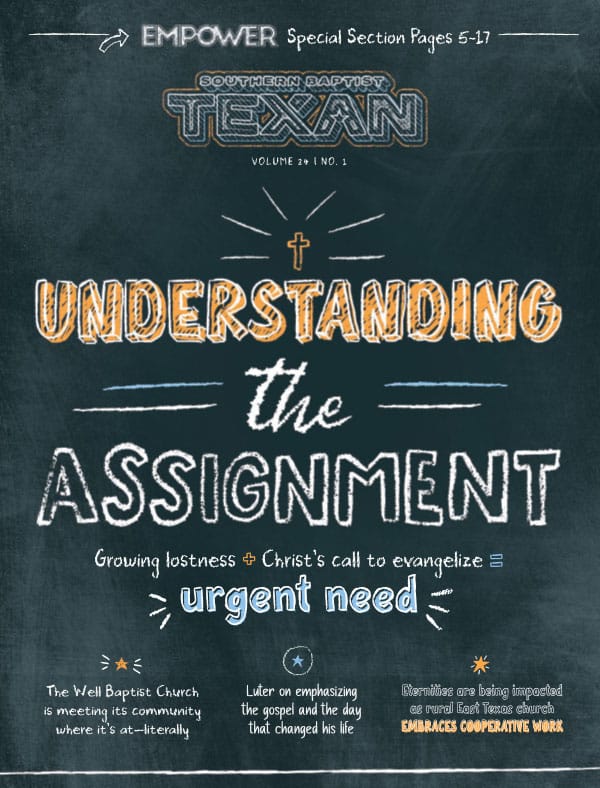Beginning in September 2012, Texas Southern Baptist churches offering Royal Ambassador (RA) and Challenger programs will no longer be able to order their missions materials through the North American Mission Board.
Responsibility for the historic missions education program created for boys in grades 1-12 has been shifted to the Woman’s Missionary Union, the SBC auxiliary group credited with developing the program in 1908.
According to an April press release, the WMU will “assume responsibility for resourcing for RA and Challengers with mission education” as part of NAMB’s organizational overhaul. Previous responsibility for RAs rested with the missions education area of NAMB’s communications group, which has developed the missions curriculum since 1997. Prior to that the former Brotherhood Commission had the task.
Former pastor Steve Heartsill has been tapped as managing editor for the resource as well as liaison between WMU and NAMB. Heartsill serves as WMU design editor of the missions leader resource team.
In the April release, national WMU Executive Director Wanda S. Lee said she is excited about the coming changes and what they will mean for local churches.
“With WMU producing these materials, it will be so much easier for churches to order all their missions education resources from just one place—WMU,” Lee said.
In a written response to the TEXAN, Mike Ebert, vice president for communications at NAMB, said the entity looks forward to working with the national WMU to bring RAs to new churches while continuing to serve churches that have faithfully offered RA programs throughout the years.
“National WMU has assured us that they will work with any church that wants to bring RAs to its congregation,” Ebert said.
However, the re-organization might prove difficult for churches uniquely affiliated with the Southern Baptists of Texas Convention, one of two state conventions lacking a working relationship with the long-time women’s missions auxiliary.
Because current WMU bylaws restrict the SBC auxiliary from having more than one relationship with conventions in any given state, it does not recognize the SBTC as a working partner in missions. Consequently, Texas WMU materials exclusively feature Baptist General Convention of Texas (BGCT) missions.
Housed in offices of the BGCT, Texas WMU promotes and hosts web content for BGCT mission projects and the BGCT’s state offering (Mary Hill Davis) on its new website. In-state training opportunities and mission camp opportunities typically focus on these same priorities.
Despite the lack of partnership between the SBTC and WMU, Tiffany Smith, SBTC missions mobilization associate, said that dually or uniquely aligned SBTC churches may still order missions education materials by contacting both SBTC and national WMU offices.
“Although the SBTC is not recognized by the WMU, this should not in any way hinder the church’s ability to have a WMU program,” Smith told the TEXAN after WMU released news of the re-organization.
And although the reorganization of responsibility over RA material compounds the long-standing problem of no relationship between WMU and the SBTC, Jim Richards, SBTC executive director, said he would still like to see a relationship established.
“My goal for the WMU-SBTC relationship is for the WMU to recognize the SBTC as a state convention. In doing so, I would want the WMU to allow the women of the SBTC churches to elect a WMU president and have a place on their board,” Richards said. “In essence I simply want the SBTC to be afforded the rights and privileges that any other state convention has in their relationship with the WMU.”
After news of the shift of RA responsibility was released, the TEXAN contacted the national WMU for clarification regarding its position toward SBTC churches. In an e-mailed response to the TEXAN, Julie Walters, corporate communications team leader of the national WMU, maintained that WMU focuses on resourcing churches with missions materials.
“While we resource the churches, we also partner with all Baptist state conventions equally for the purpose of resourcing churches with Lottie Moon and Annie Armstrong offering materials,” Walters said. “As Wanda [Lee] has communicated in the past, we relate on a state level with state WMU organizations. To say that we don’t ‘recognize’ the SBTC sounds like we ‘recognize’ all conventions and are singling the SBTC out. That is not true. Again, we desire to resource any church—regardless of their affiliation—with missions education resources.”
The WMU has also withheld a relationship with the Southern Baptist Conservatives of Virginia (SBCV).
NAMB’s Ebert told the TEXAN he understood the shift in responsibility could intensify tensions arising from the lack of relationship between the WMU and dual-convention states.
“We can’t anticipate every scenario, so we look forward to helping resolve any specific challenges a church might have as we enter this new partnership,” he said.
Yet despite no formal relationship between the WMU and the SBTC, Ebert said NAMB would like “to see more churches and more boys participating in RAs.”
“NAMB has a long history of working well in dual-convention states,” he said. “In Texas, we helped coordinate efforts last year with GPS: God’s Plan for Sharing, the evangelism emphasis in which both state conventions participated. The same was true in 2007 for Crossover San Antonio. And we work with both state conventions to help coordinate national disaster relief responses.”
The SBTC’s Smith emphasized that additional resources for missions education are available for churches that opt for other missions education programs.
“We have vision trips throughout the year to mobilize churches in missions and we work with Paula Hemphill and ‘Kingdom Women’ at the IMB.” Smith said. “In addition, we have created materials and lessons to be dropped into ongoing missions curriculum or AWANA.”
For more information regarding SBTC missions education resources, call Tiffany Smith toll-free at 877-953-7282 (SBTC) or e-mail her at tsmith@sbtexas.com.










